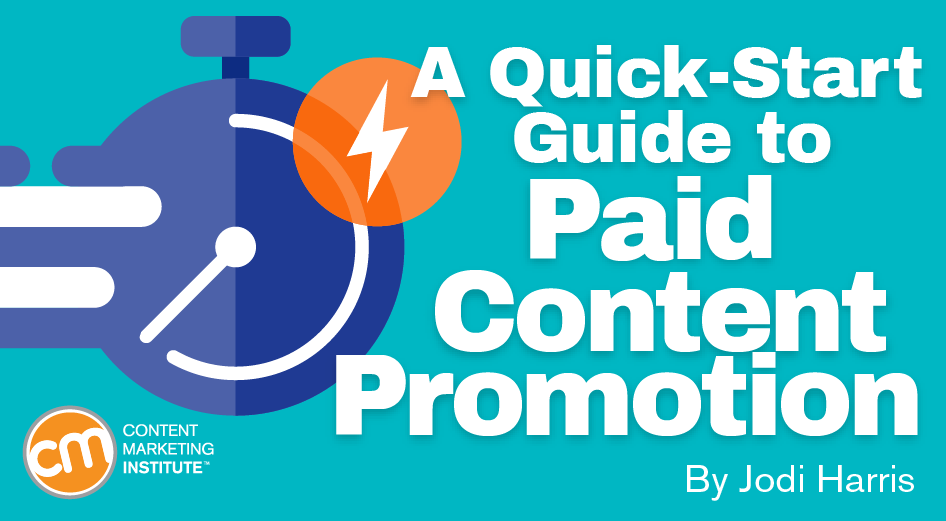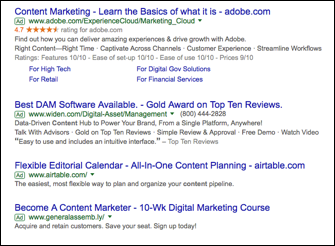Author: Jodi Harris / Source: Content Marketing Institute

No brand can exist in a vacuum. To thrive and grow, it needs a constant influx of supporters who buy into its perspectives, points, and purposes, and customers who purchase its products.
Of course, this is why marketing was invented – to draw interest by disseminating information about a brand’s favorable attributes, building desire for its products and services, and providing a clear pathway to make a purchase.
The content marketing your business creates can certainly help further all of these goals on its own; but with the high volume of noise and distractions competing for attention online, organic reach on social media in sharp decline, and search trends and algorithm changes complicating the playing field, it’s time to face a tough truth: If you want your content to get discovered by the right audience at a scale that will help further your business purpose, you’re going to need to amplify its power by incorporating paid promotion into your content marketing strategy.
I’m sure you’re familiar with the standard formats used in paid advertising – banner ads, sponsorship deals, paid product placement, and the like – and you can certainly use these techniques to promote your content just as you would a product or service. But content marketers can also take advantage of more strategic, subtle, and authentic means of getting their high-quality content efforts in front of the right consumers and helping drive them to take action.
Below is an overview of some paid promotion opportunities content marketers should be considering, along with some helpful guidance on how to get the most value from those efforts.
Native advertising

What it is: To paraphrase CMI founder Joe Pulizzi‘s definition, native advertising is an in-stream, pay-to-play technique that enables brands to display their credible, information-based content on relevant third-party sites. Rather than disrupting the editorial experience, the content used in native advertising campaigns is designed to align with the tone, format, and topical focus of the articles a reader would normally expect to find on that publisher’s site.
Why it works: Native advertising enables your business to extend its reach beyond its owned media channels, placing your content in front of new audiences who might be interested but unaware of your business or who operate outside your usual sphere of influence. Content promoted through this technique is positioned as useful, relevant information, which makes it less subject to ad blockers and “banner blindness” and more likely to be trusted.
How to work it: To benefit from native advertising’s traffic-boosting effect, select the content and the sites where you place it carefully.
Before you enter into a native advertising agreement, research carefully to make sure the audience who will see your content displayed will be complementary to your own – why pay to reach the same audience twice or to engage people who aren’t likely to share your brand’s interests, or recognize its value? This goes for working with publishers individually, as well as native advertising networks – where your content might show up on several publishers’ sites at once. And, as Ural Cebeci reminds us, just like your owned and earned media, native content needs to be held to a high standard. It needs to speak to people’s pain points, not to go for the hard sell, so it will be recognized as valuable and not overlooked as useless fluff.
You also need to consider transparency issues and make sure your content is clearly labeled as sponsored content to ensure that your native efforts don’t fall afoul of the U.S. FTC guidelines. It’s also the right thing to do, from an ethical standpoint – you don’t want your brand to be accused of propagating “fake news,” do you?
Paid search

What it is: Search engine marketing (SEM) or paid search involves purchasing ads or sponsored listings that appear on search engine results pages (SERP) when consumers search for information relevant to your content. While it may seem like a simple, straightforward concept, it’s a deceptively complicated technique to master, owing to the complex nature of keyword targeting, platform-specific display variations, ongoing algorithm changes, and a highly noisy and competitive marketplace for popular keyword terms.
Why it works: Virtually everyone uses search engines to discover content and information – often dozens of times a day (why do you think “Google It” has become the ubiquitous term for looking up a piece of information?). And with the number of organic links on a Google SERP decreasing to an average 8.5, and HubSpot research finding that 75% of users never scroll past the first page of results, it makes sense to boost your content’s chances of getting in front of eager searchers.
How to work it: The paid text-based listings function gets bumped to the top of the SERP and includes a small tag that denotes that it’s a paid spot.
Google’s search ads run on a pay-per-click (PPC) basis, using an auction-based system to determine when and how often your ad is displayed alongside the keywords you target. When it comes to managing your paid search campaigns, a working knowledge of Google’s AdWords tool is key. Through AdWords, content marketers can choose a campaign type; create their ad copy, landing page URL, and calls to action; select target keywords and audience segments; and set a budget, goals, and bid strategy for each campaign.
By setting a budget and maximum cost per click, you are bidding on how much you are willing to pay for each click your ad receives. From there, Google’s algorithm evaluates your campaign against competitors looking to target the same keyword, and determines when and how often to display your ad.
Of course, success with this technique can be elusive and fleeting. For example, according to Search Engine Land research shared on the HubSpot blog, up to 80% of people ignore Google-sponsored ads. This means it’s critical that content marketers do the homework before venturing into the wonderful world of the AdWords auction process (or the similar ad-buying processes offered by Bing and other search engines). (More info on this can be found in the additional tips section below.)
Influencer marketing

What it is: Influencer marketing programs enlist the assistance of strong voices in your industry – i.e., people who have the ear of your target audience – to help bring your content to their attention. Influencer involvement can be something simple, like regularly re-tweeting your content to their communities, or more involved, like co-producing content for collaborative publication. This technique can be leveraged on a non-paid basis. But if you are looking to engage high-profile influencers or celebrities or want to establish a consistent, long-term partnership, you will likely have to support your program with some dollars.
Why it works: Influencers have a pre-established audience receptive to their ideas and recommendations. They are well positioned to amplify reach and awareness, which, in turn, helps your content get found and consumed by the right audience. They can also lend credibility to a particular piece of content as their endorsement trades on the trust they have earned over time from their followers.
How to work it: The many approaches to using the technique all require some logistical legwork to get your influencer program off the ground. Here’s a rundown of the basic process:
- Become familiar with the notable voices in your industry and related social communities to identify influencers who may be well positioned to speak on your content’s behalf.
- Vet potential partners to identify those who align well with your brand values, voice, and content topics, and who offer the best potential to help further your promotion goals.
- Negotiate terms, fees, and deliverables for the engagement.
- Seed, track, and manage their efforts on an ongoing basis.
Additional tips: If you are considering this form of content promotion, I highly recommend checking out CMI’s complete influencer marketing guidebook, which goes into great detail on all the steps involved in leveraging influencers (both paid and unpaid) and provides customizable templates to make the process more manageable. In the meantime, these quick tips will help you navigate the process more smoothly:
- Use search to discover viable candidates: Try typing [your industry] + “blog” (or “site”) into a search field, then, use advanced search operators to expand or narrow your results.
- Clearly outline the terms of engagement: There are myriad ways to use influencers in your content promotion efforts, with varying levels of involvement on their part. Before you enlist their participation, have a clear idea of what you are asking them to do, the results you want to achieve, and what you will offer them in return for their assistance.
- Spend smartly: Just because your budget is tight doesn’t mean you can’t engage big-name influencer talent. Consider negotiating on…
Audience Team
The digital audience insights you need to build, manage and market to your digital audiences.

